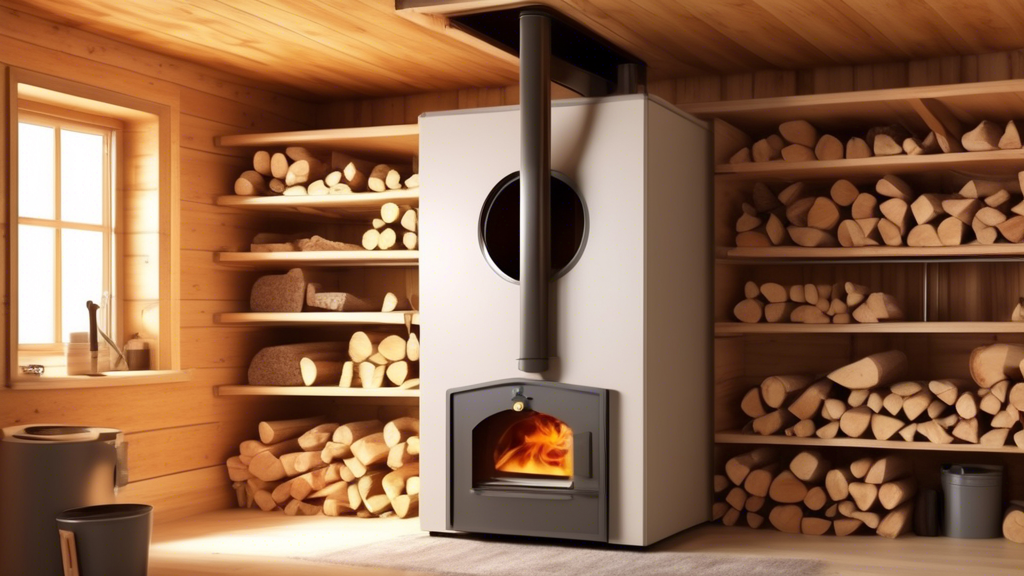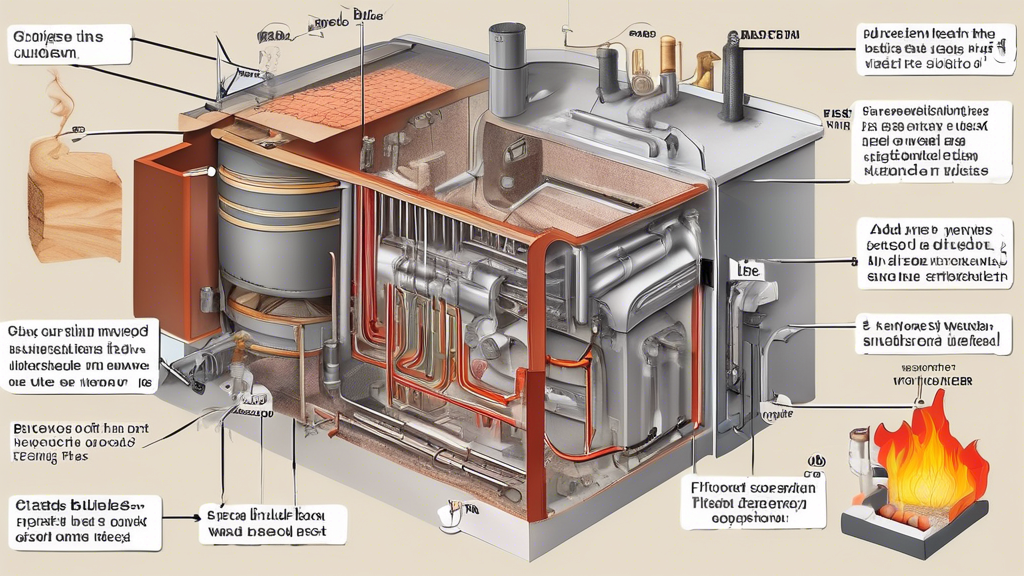Understanding How Wood Boilers Work
Wood boilers are heating up the sustainability scene (pun intended), and for good reason! These nifty devices have become a hot topic (okay, last pun, I promise) for those seeking a more eco-friendly way to stay warm. Essentially, wood boilers serve as a renewable alternative to traditional heating methods, offering a way to keep your home toasty without relying on fossil fuels. At the heart of the system, you’ll find a few key components: the firebox, where the magic—or in this case, fire—happens; the heat exchanger, which sounds a bit like a sci-fi gadget but is essentially where heat gets transferred; and the water storage tank, your home’s version of a trusty thermos, keeping hot water ready for when you need it.
What sets wood boilers apart from your run-of-the-mill heaters is their ability to maximize the use of wood—a resource that can often be sourced sustainably. While traditional systems might keep you warm, they often burn through fossil fuels faster than your Uncle Bob at a BBQ. In contrast, wood boilers offer a smokin’ solution by utilizing renewable materials while trimming down your carbon footprint like an overgrown hedge. As we dive into the mechanics of these bad boys, get ready for a step-by-step journey through how the firebox burns wood to generate heat, which then gets a first-class ticket through the heat exchanger, and finally relaxes in the water storage tank, just waiting to warm your home like a cozy cup of cocoa on a winter’s night. Fear not, we’ve got tips on how to keep your wood boiler in tip-top shape and ensure you’re making the most of your woodland wonder. Don’t worry if things start off a bit smoky—everyone, including yours truly, has set off a smoke alarm or two in the noble pursuit of DIY heating mastery!
Introduction to Wood Boilers: How Do Wood Boilers Work?
As temperatures drop and the comforting thought of cozy winter nights by the fire flickers in your mind, you might find yourself wondering how sustainable your current heating solution truly is. Enter the wood boiler, a marvel of modern innovation with old-world charm, rapidly gaining popularity as a sustainable heating alternative. But how do wood boilers work? Let’s dive into the warm embrace of these environmentally friendly systems.
First things first, a wood boiler heats your homestead by burning, you guessed it, wood! This makes it a renewable energy source—as long as you aren’t sneakily burning your neighbor’s fence. And in the age of environmentally consciousness, that’s a win! In simple terms, a wood boiler system typically consists of three main components: the firebox, heat exchanger, and water storage tank. Picture your firebox as the heart of the operation—it’s where all the magic of turning wood into heat begins. It’s essentially a chamber where your wood combusts, transforming into energy and warmth.
The heat exchanger then struts in, much like that reliable buddy at a potluck who turns up just in time with a piping hot casserole. Its job is to transfer the generated heat from the burning process to the water moving through the system. Think of it as a grand, invisible hand that balances the flow of warmth through your home.
Then there’s the water storage tank, the silent guardian of the system. It stores the hot water ready to be divvied up through your abode. Just envision a friendly librarian meticulously sorting warm water for its journey across your house, ensuring you feel the coziness from your toes to your nose.
Now, how do wood boilers work in comparison to traditional heating systems, you ask? While Grandma’s old oil furnace works by guzzling precious fossil fuels, wood boilers are set apart by their use of sustainably sourced wood as a heating agent. Call it the conscientious cousin in the family of home heating solutions. Unlike its fossil fuel counterparts, a wood boiler doesn’t top up on everyone’s favorite finite resources, allowing you to pat yourself on the back for making a big-picture environmentally sound choice.
Before we delve into the mechanics and discover just how do wood boilers work (spoiler: it’s got a lot to do with creative combustion and clever engineering), it’s essential to appreciate how wood boilers marry an age-old reliance on wood with the precise efficiency of modern-day technology. It’s like watching an old cowboy expertly wrangle a robot horse—nature meets innovation in the ultimate heating showdown.
So whether you’re sipping your morning coffee while gazing lovingly at your stockpile of logs or considering this as an unconventional yet effective solution to winter chills, understanding how wood boilers work not only warms your living space but also your commitment to Mother Earth. With the right understanding and a dash of humor, you’ll be stoking those fires with confidence—and maybe even a little pride—when the frost sets in.
Click Here For The World’s Largest Collection of 16,000 Woodworking Plans

The Mechanics of Wood Boiler Operation: How Do Wood Boilers Work?
Ah, the mysterious and sometimes smoky world of wood boilers! Let’s roll up our flannel sleeves and dive into the marvelous mechanics of how these earthy giants operate. Don’t worry if you’re feeling a bit flummoxed by the technical jargon; we’re going to break it down like a stubborn pine knot.
Turning Wood to Heat: The Firebox Adventure
First things first: the firebox. Think of it as a wood-fired belly where all the magic begins. You load this baby up with logs, light a match (safely, of course), and voila—you’re starting your journey into sustainable heating. The wood burns merrily, thanks to a well-engineered airflow system that keeps the fire alive and happy. Experiencing a firebox in action is like inviting a dragon to snuggle in your basement—minus the scales and attitude.
As the wood combusts, it releases heat energy that needs somewhere to go, much like teenagers at a rock concert. That’s where our next component, the heat exchanger, takes center stage.
The Heat Exchanger: Playing Hot Potato with Thermal Energy
The heat exchanger is the heart—and perhaps, the massive nerd—of the operation, responsible for meticulously capturing all that glorious heat from the firebox. It transfers this heat into a series of tubes filled with water, warming it up in the process. Picture an enthusiastic relay team passing around a baton, but instead of a baton, it’s blistering thermal energy.
Now you might wonder, What happens to the hot water? Enter: the water storage tank.
Water Storage Tank: The Great Distributor
Once the water is heated, it’s stored in a water storage tank, often referred to as the thermal storage reservoir. This tank keeps the water hot over prolonged periods, ensuring you have access to a steady supply whenever your home demands a cozy boost. Imagine this tank as your own personal water heater on steroids, ready to deliver warmth throughout your abode like a family of overexcited kittens snuggling at once.
This hot water can be circulated directly through your home’s radiators or be used to heat your hot water tank, giving you the dual benefits of central heating and domestic hot water.
Wood, Efficiency, and Saving the Planet: A Trio of Benefits
How do wood boilers work from an environmental angle, you ask? These wood-powered marvels are champions of renewable energy, often ranking much higher in efficiency compared to fossil-fuel-burning counterparts. They produce significantly fewer emissions, waving a cheery goodbye to most of the carbon-heavy guilt associated with more traditional heating options.
It’s like swapping a gas-guzzler for a bicycle hitched to a perpetual downhill ride—you’re saving the planet one log at a time, reducing your carbon footprint without the sweaty uphill battle.
Maintenance, or How Not to Make Your Boiler Sad
Wood boilers, much like your favorite vintage car or a cactus that got used to being overwatered, do need a bit of upkeep love to keep them running smoothly. Regular maintenance such as cleaning the firebox, ensuring air vents are unobstructed, and checking ash build-up can prolong their lifespan significantly. Don’t skip these steps, unless you’re keen on reviving the ancient art of household hypothermia.
If you’re feeling fancy, and maybe a little adventurous, you might consider calibrating your boiler’s settings or upgrading to a more sophisticated model—but fear not, trusty starter models are more than equipped to make your toes toasty.
So there you have it: an uncomplicated look at the complex machinery that is a wood boiler. Whether you’re a beginner in the world of how do wood boilers work or a seasoned fire-tamer, understanding the inner workings helps us all keep a warm hearth and a warm heart.
As we draw a close on our exploration of wood boilers, one thing is clear: these mighty machines offer a fascinating blend of tradition and innovation, all while donning a green superhero cape. So, how do wood boilers work to charm both our environment and our homes with cozy efficiency? They start modestly, burning that simple yet powerful material—wood—in the firebox. Then, like an efficient little ferryman (or maybe a fiery Cupid), the heat is skillfully shuttled through the heat exchanger. Here, it partners passionately with water, elevating it to those warm, soothing temperatures we crave when the world outside turns chilly.
But wait, there’s more! Our hero, the water storage tank, comes into play, ensuring that this delicious heat doesn’t loiter lazily in one spot. Instead, it strolls elegantly, branching out to every corner of your abode, making sure every radiator, every floorboard, even every unsuspecting cat napping in the sunbeam, benefits from its radiant embrace. What’s remarkable is that while it seems busy just heating your space, it’s also gently massaging Mother Earth’s stress knots, as wood boilers boast a commendable efficiency and a lighter carbon footprint, making them the environmentally conscious choice.
Of course, just like maintaining a good relationship (or that beloved vintage car in your garage), wood boilers require a little TLC to keep them in top-notch form. A sprinkle of routine maintenance—like cleaning out ash, ensuring the firebox is healthy and the heat exchanger is spa-fresh—does wonders. And should you run into any hiccups, remember that even seasoned pros were once newbies fumbling with kindling and combustion theories. Mistakes are just the universe’s way of giving you a nudge towards mastery and a great story to share over a cup of hot cocoa.
So whether you’re wielding top-of-the-line gear or a trusty old handsaw, remember that your journey into the wood boiler world is one of exploration and growth. Your setup doesn’t need to be fancy or ornate to work wonders; with a little persistence (and perhaps some patience when your boiler decides it’s in a mood), you’ll be cuddling in warmth while doing your bit for the planet. Stay curious, keep experimenting, and above all, enjoy the challenges and triumphs that wood heating brings to your ever-evolving workshop of life.
Click Here For The World’s Largest Collection of 16,000 Woodworking Plans

